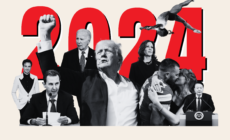-
What stores are open on Christmas Day 2024? - 12 mins ago
-
Trump’s deportations on a collision course with California’s economy - 33 mins ago
-
U.S. Fighter Jet Shot Down Over Red Sea by Apparent Friendly Fire - 37 mins ago
-
Donald Trump Says US Could Demand Return of Panama Canal - 47 mins ago
-
What Your Xmas Gift Says About Your Marriage, According to Experts - about 1 hour ago
-
Year in Review: What Moment Defined 2024? Newsweek Writers’ Verdicts - 2 hours ago
-
Encountering Italy and Germany on a Road Trip Through Southern Brazil - 2 hours ago
-
America’s Most Popular Christmas Movies Revealed - 3 hours ago
-
How Netflix’s ‘Culinary Class Wars’ Made Chef Anh Sung-jae a Star - 3 hours ago
-
Dodgers Considering Blockbuster Trade For Luis Robert Jr. - 3 hours ago
How Final NYT-Siena Poll Compares to 2016, 2020 Elections
The final New York Times/Siena College poll for the 2024 presidential election that was released on Sunday shows a slight edge for Vice President Kamala Harris over former President Donald Trump in all but one swing state.
The poll surveyed 7,879 likely voters by phone across the seven battleground states. Among those surveyed, the poll found that Harris led by three points in Nevada, 2 points in North Carolina and Wisconsin, 1 point in Georgia and had the advantage in a virtual tie in Pennsylvania. Trump had the advantage in a virtual tie in Michigan and a four-point lead in Arizona. Neither candidate had over 50 percent support in any state, continuing to add to the image of a tightly run contest with no clear advantage for either candidate.
The poll was conducted between October 24 and November 2, with a margin of error of plus or minus 3.5 points within each state.
However, Harris would have more positives to draw than Trump does. Analysis of the poll by The New York Times found that late deciders were breaking for Harris, with a 55 percent of those who only recently decided on their vote backing her compared to 44 percent for Trump.
New York Times/Siena College is one of America’s most trusted pollsters. Aggregator 538 ranks it first on its list of 282 for its historical track record and transparency. Analyst Nate Silver ranks it in the top two firms, giving it an A+ grade.
Newsweek has reached out to Trump’s and Harris’ campaign via email for comment.

Scott Olson/Getty Images
What Did the 2016 and 2020 Polls Say?
The 2016 election hurt pollsters overall as the vast majority had shown clear trends for former U.S. Secretary of State Hillary Clinton to have a healthy lead.
Many blamed then-FBI director James Comey and his announcement just days before the election to re-open an investigation into Clinton’s emails for wiping out what had been an otherwise healthy lead and taking the race into the margin of error.
Heading into election day, the Times had tracked Clinton to have a 45.9 percent support compared to Trump’s 42.8 percent nationally.
Meanwhile, the Siena College national poll for battleground states found Clinton had a seven-point advantage in Pennsylvania, even odds in North Carolina and even in Florida.
Pennsylvania famously broke for Trump, handing him a win with a .72-point gap—a mere 44,000 votes, roughly—as did North Carolina by 3.66-points and Florida by 1.2 points.
The 2016 misfire caused many pollsters to adjust the way they weighed different demographics in an effort to better capture the “Trump effect” in polling. However, those changes proved not as effective as pollsters had hoped.
The 2020 Siena College poll found Joe Biden to have a nine-point national advantage over Trump among likely voters. Biden went on to win with a 4.5-point gap, only half of what the polling had measured.
In the 2020 battleground polling released on November 1 of that year, Siena College found Biden ahead by six points in Arizona, three points in Florida, six points in Pennsylvania, 11 points in Wisconsin.
Biden did end up winning Arizona despite wider expectations of a Trump victory, but only sneaking the win with a .3-point win—a mere 10,500 votes, roughly. Trump handily won Florida by 3.5 points, and Biden did take back Pennsylvania, but again only with a slight gap of around 1.16 points.
Biden also did end up taking Wisconsin, but by a much slighter .63-point gap.
Can We Trust the Polls?
Polling has suffered a significant reputational hit over the past two elections, with polling indicating that Clinton would beat Trump in 2016 and that Biden had a greater advantage than he ended up winning in 2020.
“While the polls aren’t so precise that you can trust they’ll nail a tight election, you can’t assume that the polls will badly err again, either, as they did in 2016 or 2020,” Cohn, chief political analyst for the Times, wrote Friday in a piece published in Upshot.
Both of those previous polls underestimated Trump’s support, with many finding in 2016 that his supporters were less likely to voice their support for the highly controversial candidate.
Cohn highlighted “major methodological changes” in polling data, noting that “many of the worst-performing pollsters of 2020 have either adopted wholesale methodological changes or dropped off the map.”
Some of those changes, though, made to compensate for underrepresenting Trump may have led to underrepresenting Harris instead, Cohn warned.
“It’s hard to overstate how traumatic the 2016 and 2020 elections were for many pollsters,” he wrote. “For some, another underestimate of Mr. Trump could be a major threat to their business and their livelihood. For the rest, their status and reputations are on the line.”
He added: “If they underestimate Mr. Trump a third straight time, how can their polls be trusted again?” he continued. “It is much safer, whether in terms of literal self-interest or purely psychologically, to find a close race than to gamble on a clear Harris victory.”
Source link






















